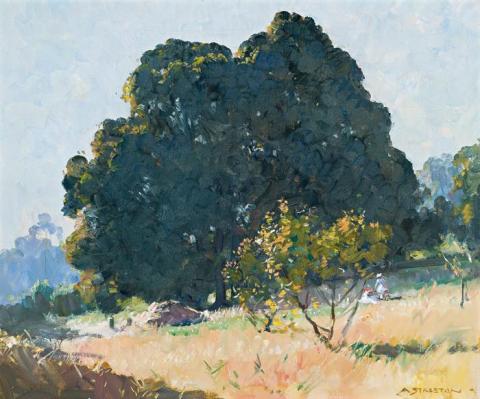AFTERNOON LIGHT (BLACKWOOD TREE), 1934
Arthur Streeton
oil on canvas
51.0 x 61.5 cm
signed lower right: A STREETON title
inscribed verso: Afternoon Light, No 29
Athenaeum Gallery, Melbourne
John R. Hogan, 1954
Private collection
Thence by descent
Christie's, Melbourne, 27 April 1998, lot 112
Private collection, Sydney
Exhibition of Arthur Streeton's Paintings, Athenaeum Gallery, Melbourne, 4 –16 June 1934, cat. 22
Streeton, A., The Arthur Streeton Catalogue, Melbourne, 1935, cat. 1101
Arthur Streeton's purchase of land at Olinda in the Dandenong Ranges enabled him to turn his attention to his more immediate surrounds, producing paintings inspired by the garden on his property at 'Longacres', as well as the majestic vistas of the surrounding ranges and their valleys. The blackwood tree in this painting grew at Longacres, being one of a number that attracted Streeton to the area in the first place. In 1921 he wrote to his old friend Tom Roberts that he was 'striving to buy' some acres on top of Olinda. The top part is cleared of all except about 10 fine blackwoods, most beautiful trees (and the blossoms, as you know, a soft yellow like pale butter)' and [he added] there's just nice room for a little home, to be built with the blackwoods surrounding it...'1 Living at Olinda from the mid-twenties on, Streeton developed an increasing concern for conservation in the face of destruction of the nearby forests. This led to trees becoming the greater focus of his attention, the blackwoods on his own land, and those gums surviving or destroyed, nearby. Important paintings include Last of the Messmates, 1928 (private collection) with its single standing tree, and the fallen hero, cut and dismembered in A Mountain Side, 1935 (Westpac Banking Corporation). His 1929 solo exhibition at the Fine Art Society's Gallery, Melbourne, included Our Vanishing Forests and Longacre Blackwoods, together with the now numerous paintings of sunflowers, Canterbury Bells, Michaelmas Daisies and other flowers from his Olinda garden. The individual tree as the single or dominant motif is not unique in Streeton's oeuvre. There are many Australian works, several featuring the blackwood, and in Canada in 1923 he painted The Oak, Vancouver Island. Afternoon Light (Blackwood Tree), 1934, however, is special, the noble gum so typical in much of his painting now humanised by its setting within the artist's garden. This is continued through the introduction of the small picnic group to the right, taking advantage of the tree's protection and shelter from the summer heat. Here are shades of the golden summers of youth in days of yore at Heidelberg. Olinda was a haven for Streeton, an Arcadia in his later years, as this painting clearly shows.
1. Streeton, Letter to Roberts, Melbourne, 13 August 1921 cited in Croll, R. H., Smike to Bulldog: Letters from Sir Arthur Streeton to Tom Roberts, Ure Smith Pty Limited, Sydney, 1946, p. 105
DAVID THOMAS
